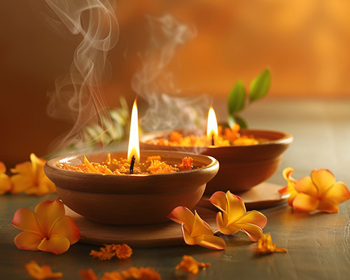- Divine Protection: The Chandi Path Puja is known to invoke the powerful protection of Goddess Durga, shielding devotees from negative energies, evil influences, and dangers.
- Victory Over Obstacles: This ritual is performed to overcome challenges and adversities, be they physical, emotional, or spiritual.
- Spiritual Empowerment: Reciting the Devi Mahatmyam during the Puja strengthens the devotee's inner resolve, courage, and willpower, empowering them to face life's difficulties with confidence.
- Purification and Cleansing: The Puja purifies the mind, body, and surroundings, removing impurities and fostering a sacred, positive environment.
- Attainment of Desires: It is believed that sincere devotion and performance of the Chandi Path Puja can fulfill desires, bringing prosperity, happiness, and success.
- Removes obstacles and ensures success in endeavors.
- Provides protection from negative forces and evil influences.
- Enhances inner strength, courage, and determination.
- Promotes peace, harmony, and prosperity in life.
- Helps in spiritual growth and achieving a higher state of consciousness.
- Cleanses the environment and creates a positive aura.
Chandi Path Puja is a powerful and complex Hindu ritual dedicated to Goddess Chandi, an aggressive form of the Divine Mother, Durga. The puja involves reciting the Durga Saptashati (or Devi Mahatmyam), a collection of 700 verses praising the Goddess, spread across 13 chapters. Performing this puja requires devotion, purity, and adherence to specific rituals.
Here's a step-by-step guide to performing Chandi Path Puja:
1. Preparation
- Purification: Take a bath early in the morning and wear clean, preferably white or red clothes.
- Setup: Create a sacred space or altar (puja mandap) where the puja will be performed. Clean the area thoroughly and purify it with water mixed with Ganga Jal (holy water) and cow dung, if available.
- Idol/Image: Place an image or idol of Goddess Durga or Chandi on the altar. Arrange the necessary items such as flowers, incense sticks, lamps, betel leaves, fruits, and other offerings.
2. Sankalp (Taking the Vow)
- Meditation: Sit facing east or north, and meditate on Goddess Chandi.
- Sankalpam: Take water in your right hand, chant the sankalp mantra to express your intention to perform the Chandi Path, and then release the water into a plate or at the base of the idol.
3. Invocation of Deities (Aavahan)
- Ganesha Invocation: Begin by invoking Lord Ganesha, the remover of obstacles, with the Ganesha mantra.
- Guru and Other Deities: Invoke your Guru, the Navagrahas (nine planets), and other deities, asking for their blessings.
4. Worship of the Kalash (Pot)
- Kalash Sthapana: Fill a Kalash (pot) with water, place mango leaves around the opening, and place a coconut on top. This symbolizes the presence of all deities.
- Worship the Kalash: Perform aarti to the Kalash and offer flowers, rice, and sandalwood paste.
5. Chandi Path Recitation
- Nyasa: Perform nyasa by touching various parts of your body while reciting specific mantras to purify and prepare yourself for the recitation.
- Devi Mahatmyam/ Durga Saptashati: Recite the 700 verses of the Durga Saptashati. You can also divide the reading into three parts if you're doing it over three days.
- First Chapter: Madhu and Kaitabha Vadh (Slaying of Madhu and Kaitabha).
- Second to Fourth Chapters: Mahishasura Mardini (Slaying of Mahishasura).
- Fifth to Thirteenth Chapters: Slaying of Shumbha and Nishumbha.
- Offerings During Recitation: While reciting, offer flowers, rice, and other items at specific verses.
6. Havan (Fire Ritual)
- Setup for Havan: Arrange the havan kund (sacred fire pit) and prepare the sacred fire with ghee, wood, and samagri (havan ingredients).
- Offer Ahutis: Offer ahutis (oblations) of ghee and samagri into the fire while reciting the Chandi Path or specific mantras.
- Havan Mantras: Chant the mantra "Om Aim Hreem Kleem Chamundaye Vichche" or the specific verses of the Durga Saptashati during the havan.
7. Purnahuti (Final Offering)
- Coconut Offering: As a final offering, place a coconut into the fire, symbolizing the culmination of the havan.
- Aarti: Perform the aarti to Goddess Chandi, sing bhajans, and offer the lit camphor.
8. Prasadam Distribution
- Blessings: Pray to the Goddess for blessings, prosperity, and protection.
- Prasadam: Distribute the prasadam (blessed food) among the participants.
9. Conclusion
- Udvasan (Conclusion): Thank and bid farewell to the deities with proper mantras. Perform visarjan (immersing the idol if it’s made of clay) or carefully store the idol/image.
- Dissolve the Kalash: Offer the water from the Kalash to plants or a sacred tree.
- Cleanup: Clean up the area after the ritual, ensuring that the sacredness is maintained.
10. Additional Observances
- Fasting: Some devotees may observe fasting during the puja, consuming only fruits and water until the completion.
- Brahmacharya: Maintain celibacy and purity of thought during the days of the puja.
- Meditation: Spend time meditating on Goddess Chandi, especially after the puja.
Notes:
- Proper Guidance: If performing the Chandi Path for the first time, it is advisable to do so under the guidance of a knowledgeable priest or guru.
- Purity: Ensure that you and the surroundings are kept pure and sanctified throughout the ritual.
This ritual is deeply spiritual and can invoke the protective and transformative power of the Goddess when performed with sincerity and devotion.




